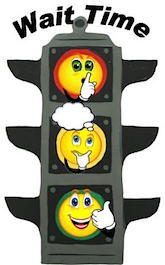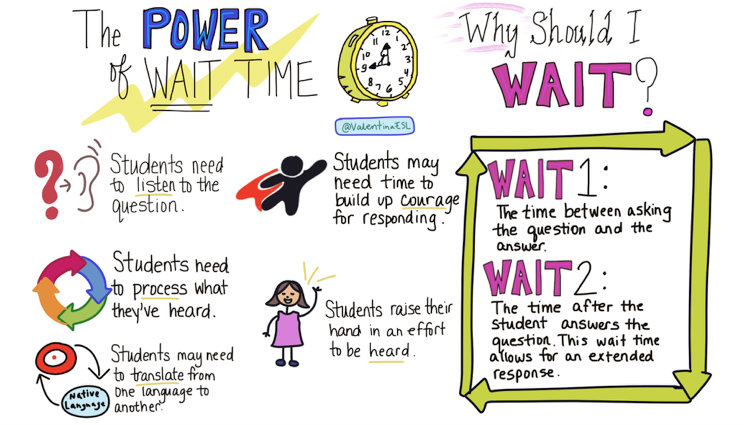School Leadership 2.0
A Network Connecting School Leaders From Around The Globe
Wait Time Can Make or Break Your Lesson
Wait Time Can Make or Break Your Lesson
BY VALENTINA GONZALEZ · PUBLISHED 04/08/2018
A MiddleWeb Blog
 Wait Time…it can make or break a lesson. How can something so simple have such an incredible impact? It’s the difference between a student fully being engaged and participating and a student becoming frustrated and checking out.
Wait Time…it can make or break a lesson. How can something so simple have such an incredible impact? It’s the difference between a student fully being engaged and participating and a student becoming frustrated and checking out.
Like many effective ELL strategies, “Wait Time” is good teaching practice across the board. It supports special needs students, introverts, and many others who are struggling to keep up academically (see the resources at the end of this post).
Here, I want to look more closely at the impact of wait time for English Language Learners.
Why wait?
When students are learning a new language, they benefit from time to listen to the question and process what they’ve heard. Many students need additional time to take the words they heard and translate them in order to comprehend the message. Once they understand the question, they need time to formulate a response in English and build the courage to use their voice.
Not all ELLs find this an easy task. For me personally, as a young ELL, this was the most difficult part of the equation and exactly where I got stuck. I couldn’t find the courage within the wait time I was given. But if a student has built up enough courage they will raise their hand and hopefully be called on to respond.
TIP: To lower the affective filter of ELLs and help them build the courage to respond, embrace a growth mindset about language learning. Even if the response is not grammatically correct, it’s the risk and the learning that are important. Never publicly correct an ELL’s grammar. The best way to help students who make a grammatical error is to recast.
For example, if a student says, “The water evaporate because of heat,” you can simply respond by saying something like, “Yes, the water evaporated because of the heat.”
How ELLs react without enough Wait Time
When we don’t give enough Wait Time for all of this to happen, we shut our ELLs down before they move past translating what we’ve said. At this point some will get frustrated. Others will tune us out. Many will start to think that the questions are not for them, so why should they listen.
Wait Time is a clear message to all of our students that the lesson and the learning are for them. They are important, and we will not give up on them. Waiting an extra 3-5 seconds after asking a question seems like a small thing to do, but it has large outcomes. Research by Mary Budd Rowe says that when we implement this extra wait time, student responses increase significantly.
Rowe defined wait time as the time between when the teacher asks a question and the student responds. This is also called Wait Time 1. She found that, traditionally, wait time has been less that 1.5 seconds. However, by doubling wait time to 3 seconds, several positive effects were experienced:
- the length of responses increased
- the correctness of responses increased
- more students volunteered answers
- “I don’t know” responses decreased
- student confidence increased
Even teacher behaviors benefit from extended wait time. The quality of teachers’ questions increases while the number of questions asked decreases. Quality over quantity!
Now add Wait Time 2 to support learning
Wait Time 2 is the time after the student responds and the teacher replies. Waiting an additional few seconds here can elicit an extended response from students. In some cases, the teacher may nod or give an “umm.” A nonverbal signal that the teacher is considering allows students an opportunity to continue responding. Students may not always be able to add any additional information, but Wait Time 2 is an opportunity for extra output and elaboration.
Scenario 1:
Teacher: Samantha, why did the water evaporate?
Samantha: Because of the heat.
The rest of the class: They are all thinking…Why should we waste our energy on thinking about an answer or focusing on what the teacher is saying right now? She’s talking to Samantha anyway, not us. So they check out.
Scenario 2 with Wait Time:
 Teacher: Why did the water evaporate? (insert wait time here) When you can finish this sentence, stand up. “The water evaporated because…” (insert wait time here) Share with your elbow partners and then take your seat.
Teacher: Why did the water evaporate? (insert wait time here) When you can finish this sentence, stand up. “The water evaporated because…” (insert wait time here) Share with your elbow partners and then take your seat.
Students: (Think, stand, share, sit)
Teacher: Samantha, why did the water evaporate?
Samantha: The water evaporated because of the heat.
Teacher: (nods and looks up as if thinking – Wait Time 2) Hmmm…
Samantha: Heat from the hot plate evaporated the water just like the sun’s heat evaporates water outside when there’s a puddle.
In the new version, the teacher implemented Wait Time 1 and Wait Time 2. During Wait Time 1, all students had an opportunity to think about the answer to the question. Everyone was involved in the questioning and answering.
When the teacher offers a sentence stem, students can more readily respond to the content in the question. The stem is not required, rather it is there to help students who need an extra push to get their thoughts going.
Asking students to stand when they are ready to share, gives everyone time to formulate a response. This way no one is caught off guard.
When I was in high school, I had a teacher who always asked the off-task student to answer a question. It seemed like her goal was to embarrass the kid who wasn’t paying attention. We know now that that type of questioning does not support learning. It doesn’t make students want to learn or make them feel safe.
Partner sharing
Creating a safe environment that supports learning and risk taking is important. Instead of just calling on one student to respond, allowing everyone to share first with a partner gets 100% participation. All kids are talking and listening.
 I love this strategy also because if a student didn’t have a great answer, then at least they heard from a partner and may have learned something more from them. This partner-share prepares students in case they are called on to share with the whole group too.
I love this strategy also because if a student didn’t have a great answer, then at least they heard from a partner and may have learned something more from them. This partner-share prepares students in case they are called on to share with the whole group too.
In Scenario 2 above, Samantha had already shared with a partner, so she was warmed up and had an idea from her partner if she needed it.
Since the teacher nodded and made a “thinking sound” – and didn’t cut Samantha off right after her initial response – she was given a second Wait Time. This allowed Samantha to extend her response. Wait Time 2 leaves the door open for students to continue their thoughts.
Small change – Big rewards!
For additional information on teaching with Wait Time, here are a couple of good resources:
► Using Think Time by Robert Stahl
► Wait Time: What’s In It For Me? by Jackie Walsh
Tags:
Replies to This Discussion
JOIN SL 2.0
SUBSCRIBE TO
SCHOOL LEADERSHIP 2.0
Feedspot just named School Leadership 2.0 one of the "Top 25 Educational Leadership Blogs"
"School Leadership 2.0 is the premier virtual learning community for school leaders from around the globe."
-------------------------
As has been our custom, School Leadership 2.0 will donate 100% of new membership fees in the the month of May to LI Cares.
---------------------------
Our community is a subscription based paid service ($19.95/year or only $1.99 per month for a trial membership) which will provide school leaders with outstanding resources. Learn more about membership to this service by clicking one our links below.
Click HERE to subscribe as an individual.
Click HERE to learn about group membership (i.e. association, leadership teams)
__________________
CREATE AN EMPLOYER PROFILE AND GET JOB ALERTS AT
SCHOOLLEADERSHIPJOBS.COM
